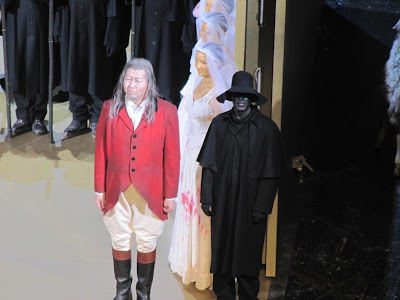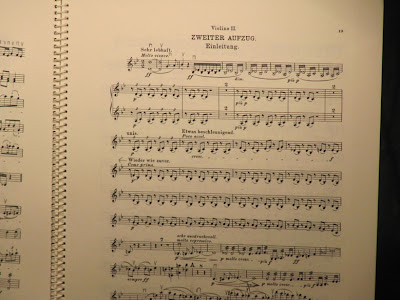Karsten Wiegand ..... Director
Stefan Solyom ..... Conductor
Franco Farina ..... Tristan
Marion Ammann ..... Isolde
Hidekazu Tsumaya ..... König Marke
Tuija Knihtilä ..... Brangäne
Sebastian Noack ..... Kurwenal
Alexander Günther ..... Melot
Szabolcs Brickner ..... A shepherd/A young sailor
Andreas Koch ..... A steersman
Staatskapelle Weimar, Chorus of DNT Weimar
Stefan Solyom ..... Conductor
Franco Farina ..... Tristan
Marion Ammann ..... Isolde
Hidekazu Tsumaya ..... König Marke
Tuija Knihtilä ..... Brangäne
Sebastian Noack ..... Kurwenal
Alexander Günther ..... Melot
Szabolcs Brickner ..... A shepherd/A young sailor
Andreas Koch ..... A steersman
Staatskapelle Weimar, Chorus of DNT Weimar
Tristan und Isolde is to me the most beautiful piece of music ever to be composed. It so deeply reflects the conflict between rational and irrational that characterizes every human soul... It subtly emphasizes that delightfully scary side of ours' which in some circumstances can shake and destroy all our life principles -- make us do impossible, be it constructive or destructive, and thereby make us change as persons. Musical appeal of this glorious piece comes from the fact that it is never assessed as a statement, it never reaches a plateau or closes a circle. Instead it is a perpetually changing structure, its shape is constantly being enriched by yet another leitmotiv and so it evolves. Better still, you --as a listener-- can never fully seize it, never fully understand it...
I guess that's what makes this opera so hard to stage. If you try and make it too descriptive you will necessarily trivialize its content and diminish its musical impact on a listener. If, on the other hand, you try and project your own perception or fantasy of this opera, you will be putting your own frame to the music and --so constrained-- the whole thing will not fly off to cut through to the listener's subconsciousness. Perhaps more than other operas, I believe Tristan is suitable for a Bob Wilson's kind of theatrical language. Unfortunately I am not aware of any Bob Wilson's production of Tristan, but I know about two others that came this close to what I believe would be a 'winner'. Christof Loy was an inch to the sublime in Act-1 of his show in London a couple of years ago, but then fell apart in the middle of Act-2. Marthaler's Tristan in Bayreuth was very close too but in a way almost complementary to Loy's. They both managed to set a stage action as contours without ever impeding the musical impact. Apparently during the first year of Marthaler's show in Bayreuth, Tristan and Isolde never touched each other. Later on, after so much talk and outrage by some (judgmental) Wagnerites, Marthaler was forced to revise his Act-2 and the result is what you can now find on DVD [when in right mood for this opera, please do watch this DVD!]
Tristan und Isolde is obviously a huge challenge for singers and rare are those who are capable of singing it really good. While we are lucky to live in an era of several great Isolde's (Waltraud Meier, Nina Stemme, but also Katarina Dalayman, Irene Theorin, and quite a few other fantastic Wagnerian sopranos), the role of Tristan seems to be a tough cookie for heldentenors of our time. Stephen Gould will hopefully rise to a challenge, but so far it was just too difficult, too energy-draining... although Clifton Forbis, Robert Gambill, Ian Storrey... delivered admirable performances.
This is why Franco Farina's Tristan made such a mind blowing impression on all of us who were in Weimar for the premiere of the new production by Karsten Wiegand. You normally expect the heldentenors to mature, to explore various Wagnerian roles before taking on probably the greatest operatic role, which is Tristan. Franco Farina's career was revolving around Verdian roles, and I thought his Tristan-adventure would end after Act-1 of Saturday's premiere; if not then after the second act I though he would simply run out of gas. How wrong was that!? He sang the role gloriously, fearlessly attacking every note, and riding on the orchestra in full voice at every stage of the show. Act-3 was just incredible because when you'd expect him to lose in intensity he seemed to add an extra blast of energy! I hope he can figure out how to redistribute his energy better to be able to keep singing this role so well for more than a few shows. Otherwise, singing a series of 8-10 shows the way he sang this premiere is simply not humanly possible.
While Farina was the biggest surprise --which, somewhat funnily, has set the reserved German crowd into an uncontrolled outburst of "Bravo"-s during the curtain call-- not less surprising was Isolde by Marion Ammann. Her voice is perhaps not as beautiful as Nina Stemme's but her Isolde possesses a rare quality of Wagnerian sopranos: every word that woman utters is perfectly understandable. Also praise-worthy is her faculty to reach effortlessly all the high notes without lowering her vocal volume. The most impressive part of her performance, however, was the fact that she sustained that high voltage singing throughout the entire evening. Tuija Knihtilä's Brangäne is impressively powerful too although her pronunciation was not nearly as good as Marion's. Sebastian Noack's Kurwenal sounded very well too.
It is of course a treat for any good orchestra to perform Tristan. Stefan Solyom is apparently beloved in this house (he's the house's musical director), and one cannot deny him a quality of trying to make this score sound a little different. I am not sure I liked the fast paced Act-1 or the weirdly redistributed sound in Act-3, but you must salute his audacious reading that makes Tristan sound different ["refreshing" would not be a right word to use, but you get where I'm aiming at...]
As for Karsten Wiegand... it was difficult for me to say much right after the show. I very much liked Act-1, which is focused onto a huge bed on which Isolde is getting rid of her wedding gown to tell her story to Brangäne. Right behind them is a huge window shutter through which you can see Tristan's ship with sailors on it (including a prostitute.) Tristan will finally come to Isolde and after they've drunk the love-potion, the flow of growing love is interrupted by the arrival of King Marke -- who comes with his cheery suite, ready to celebrate the King's marriage to Isolde. Brangäne is busy helping reluctant Isolde to put the wedding dress back on, and pulls her away from Tristan.
Act-2 started off wonderfully...
until Tristan showed up. He entered the stage on a small golden boat (on wheels!) and the moment he stepped out of it, hundreds of colored party ribbons spooled out from above the stage. A detail? Maybe, but it screwed up my attention. Seriously, what's the point? To picture that the two live in their world in which everything is so sweet and colory?! Why wouldn't you put a little steam instead?
Then during "O sink' hernieder, Nacht der Liebe" they lay down in that boat (floating?!)... Finally Marke arrives from hunting, and bang -- the love scene is interrupted, King's people are horrified, Marke is heart-broken. The scene in which Tristan accuses Melot of being in love with Isolde of course culminates with Melot stabbing Tristan, but here it is particularly well guided because Wiegand decided Melot in this production was a catholic priest -- a Cardinal, in fact. Isn't that idea just brilliant?! Perfectly fitting the story!
Act-3 is depicting the life of Tristan. On the stage that is turning around its vertical axis, he goes from one room to another as if they were compartments of his life, his childhood (stuffed sheep are all over the place), his mother... but also his desires, and his unrealized dreams. Replicas of Isolde --woman in a wedding dress-- surround the bed we saw in Act-1, wrap it in tulle (bridal illusion), and suddenly the blood sprinkle all over the place [that's his unrealized dream], which is basically where his story breaks, and soon after Isolde would step in to sing "Mild und leise wie er lächelt", to join him in death -- death that becomes life to their love. While Tristan was going through his life, the stage was progressively populated by "men in black" -- the death.
So there are nice ideas, the flow is good and it is a pleasant (even if a bit too descriptive) show. I don't know if it is Wiegand or his stage designer [Bärbl Hohmann] "to blame" for the party ribbons, golden cushions on silly-wheeled boat, or for too much stuffed sheep... These unnecessary details only reinforce my statement from the beginning of this post: You should not be totally explicit in your intentions when directing Tristan [corollary: assume the public is able to understand your intentions even when they come from little suggestive gestures among the characters.]
In spite of these too explicit details that spoil the pleasure of riding high with music, and after thinking some more about the show, I did like Wiegand's production. Hopefully they will find money for a DVD release of this show --with these singers, this orchestra [but please without colored ribbons or that silly boat.]
Here is a lot of production photos [© Candy Welz and Bernd Uhlig]:
and the curtain call pics taken by Yours Truly:
 |
| Franco Farina |
 |
| Marion Ammann |
 |
| Hidekazu Tsumaya - King Marke (a "death" guy next to him, the replica brides behind) |
 |
| Tuija Knihtilä - Brangäne |
 |
| Alexander Günther (Melot) and Sebastian Noack (Kurwenal) |
 |
| Stefan Solyom |
 |
| Karsten Wiegand |
 |
| Isolde & Tristan |
 |
| Nice theater from the outside. The statues in front are those of... |
 |
| Goethe and Schiller, who both lived/created and died in Weimar |
 |
| Auditorium |
 |
| Pleasant space to spend time during intermissions... |
 |
| "Foyer" |
 |
| Not to forget why I was there :) |
























The sheep are pure Damien Hirst, while the hunting scarlet reminds me of a production of Mame I saw with Ginger Rogers.
ReplyDelete